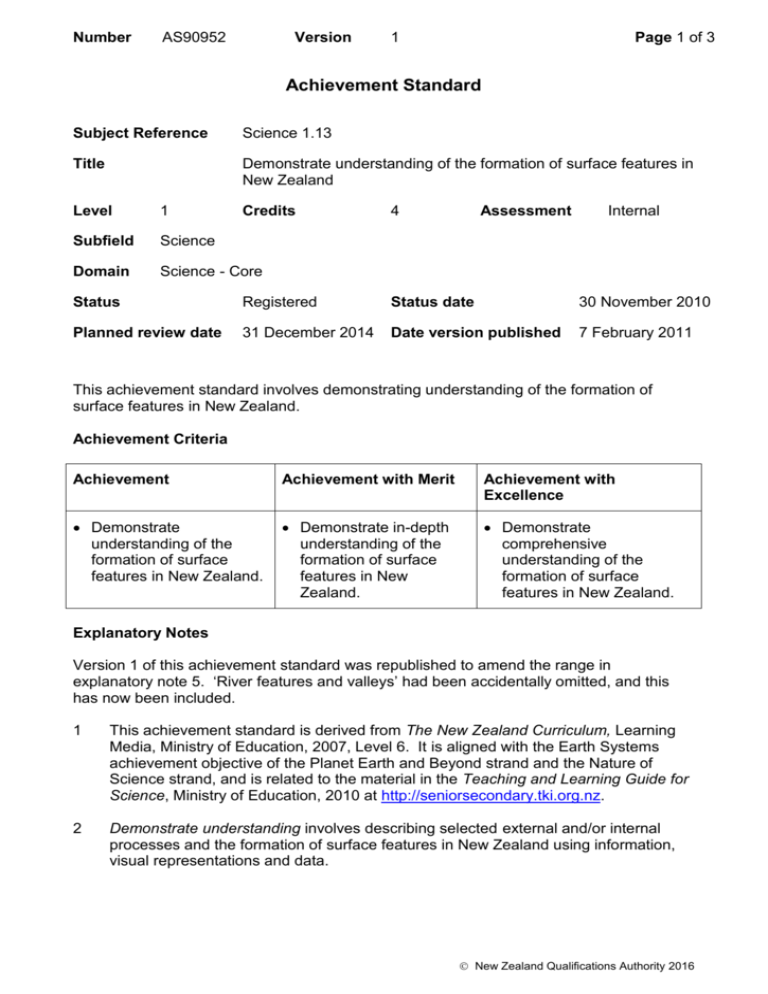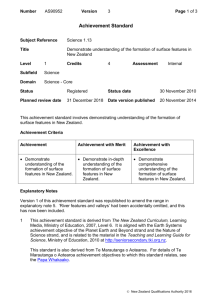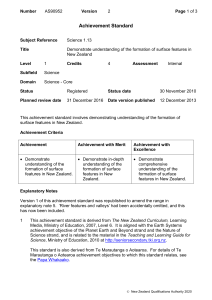90952 Demonstrate understanding of the formation of
advertisement

Number AS90952 Version 1 Page 1 of 3 Achievement Standard Subject Reference Science 1.13 Title Demonstrate understanding of the formation of surface features in New Zealand Level 1 Credits Subfield Science Domain Science - Core 4 Assessment Internal Status Registered Status date 30 November 2010 Planned review date 31 December 2014 Date version published 7 February 2011 This achievement standard involves demonstrating understanding of the formation of surface features in New Zealand. Achievement Criteria Achievement Achievement with Merit Achievement with Excellence Demonstrate understanding of the formation of surface features in New Zealand. Demonstrate in-depth understanding of the formation of surface features in New Zealand. Demonstrate comprehensive understanding of the formation of surface features in New Zealand. Explanatory Notes Version 1 of this achievement standard was republished to amend the range in explanatory note 5. ‘River features and valleys’ had been accidentally omitted, and this has now been included. 1 This achievement standard is derived from The New Zealand Curriculum, Learning Media, Ministry of Education, 2007, Level 6. It is aligned with the Earth Systems achievement objective of the Planet Earth and Beyond strand and the Nature of Science strand, and is related to the material in the Teaching and Learning Guide for Science, Ministry of Education, 2010 at http://seniorsecondary.tki.org.nz. 2 Demonstrate understanding involves describing selected external and/or internal processes and the formation of surface features in New Zealand using information, visual representations and data. New Zealand Qualifications Authority 2016 Number AS90952 Version 1 Page 2 of 3 3 Demonstrate in-depth understanding involves explaining selected external and/or internal processes and the formation of surface features in New Zealand using information, visual representations and data. 4 Demonstrate comprehensive understanding involves explaining thoroughly links between selected external and/or internal processes and the formation of surface features in New Zealand using information, visual representations and data. It may involve elaborating, applying, justifying, relating, evaluating, comparing and contrasting, and analysing. 5 Surface features may include one or more local and/or national features such as: volcanoes and/or volcanic features limestone formations such as caves, sink holes sand dunes and dune lakes landslides glacial features and valleys river features and valleys fiords, drowned river valleys mountain ranges such as the Southern Alps, Kaikoura Mountains, Tararua Ranges the Alpine Fault and other major fault lines. 6 External processes may be selected from: erosion and weathering as caused by wind, ice, water, animal and plant action, human action, sea level changes. 7 Internal processes may be selected from: formation of volcanoes or mountains due to collisions between the Pacific plate and Australian plates lateral movement along tectonic plate boundaries formation of volcanoes by hot spots movement along fault lines, folding, faulting, and uplift land movement due to earthquakes. 8 Conditions of Assessment related to this achievement standard can be found at www.tki.org.nz/e/community/ncea/conditions-assessment.php. Replacement Information This achievement standard replaced unit standard 6358. New Zealand Qualifications Authority 2016 Number AS90952 Version 1 Page 3 of 3 Quality Assurance 1 Providers and Industry Training Organisations must be accredited by NZQA before they can register credits from assessment against achievement standards. 2 Accredited providers and Industry Training Organisations assessing against achievement standards must engage with the moderation system that applies to those achievement standards. Accreditation and Moderation Action Plan (AMAP) reference 0233 New Zealand Qualifications Authority 2016








